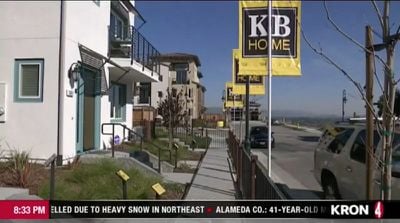With Apple known to be partnering with various building companies to integrate its HomeKit platform into new houses, one journalist yesterday was invited by KB Home to check out the company's latest HomeKit-enabled development in San Jose, California.
KRON4 tech reporter Gabe Slate's peek inside one of the smart houses demonstrates the extent of the HomeKit integration, which costs $2500 per house and includes a number of HomeKit-enabled smart devices.

Using just their iPad or iPhone, the homeowner is able to control the Kwikset lock on the front door, adjust room temperature via the Ecobee thermostat, adjust the Philips Hue lighting around the house, and lower and raise Lutron shades in the various rooms.
Meanwhile in the living room, the homeowner is able to control the fans in the rooms upstairs using the Siri Remote on an Apple TV, and activate a movie watching mode that dims the lights and brings down the blinds.
KB Home has offered home automation as an option in its houses for about 10 years, but before Apple's entry into the smart home space with HomeKit, homeowners typically had to use a different app for each smart product in the houses.
"In some respects, what KB Home is doing makes sense," said IDC researcher Jonathan Gaw, speaking to The Mercury News. "It's much easier to have some smart home products like light switches installed by a home builder when a house is constructed. Also, rolling the costs for those products into the home mortgage allows home buyers to more easily afford them upfront — and helps builders sell a higher priced home."
The convenience of smart home integration could be a big draw for a new generation of tech-savvy homeowners. Some of KB Home's houses have USB chargers built into the power outlets, for example. However, Gaw warns of the risk of obsolescence hitting a still nascent industry.
"It"s not clear yet exactly what products consumers will really want or use or even what smart home product companies will be around in five or ten years," he said. "Customers may find in six months or a couple years that they don't use the products they have or that they're defunct or no longer supported."
Last week, German pre-fabricated home company WeberHaus announced plans to support HomeKit in its SmartHomes starting in 2017, making it the first homebuilder in Europe to officially support Apple's home automation system.
























Top Rated Comments
The $2500 includes:
The entry door lock.
The Hue lights around the house.
The Lutron shades.
The Ecobee thermostat.
Upstairs fans integration.
Movie scene integration.
All installed and working with HomeKit.
Older HomeKit light switches and thermostats will continue work regardless of how great new replacement model is. And if the updates are significant enough, it's not like you have to replace every single devices at once. And with HomeKit, a device will continue to work even if the company goes out of business.
And I frankly don't think these HomeKit devices are all that expensive. If you are trying to update every single things in the house with HomeKit, the cost could add up. But you can replace them in piece meal as it makes sense to you.
HomeKit integration is not ready for most "normal" people yet if Siri can't understand that "television" and "TV" are the same thing. Right now, I think Siri's idiocy is one of the fatal flaws with HomeKit. Apple touts Siri integration as one of the main selling points of HomeKit; but when you're talking to something that sometimes lacks basic logic, it's incredibly frustrating. Here's hoping that Siri gets some long overdue updates this year.
21 Hue Lights
Ecobee 3
2 Schlage Connect Deadbolts
2 Hunter Fans
Two Lutron switches
Two bluetooth controlled outdoor security lights
3 Nest Protects
We spent another 3K on a home server / media center setup. unifi Switch, router, 4 access points, Synology server with 32 terabytes of storage, Cat 6 Wiring in every room, whole home audio w/ Sonos, an Alexa or Dot in every room.
Wall mounted iPad mini 4 w/ a wall mount in every room so you can carry it around with you to make a Home command and then dock it on the wall or kitchen (nice for reviewing recipes)
-----
After about 2 weeks of living with the system, it's really nice BUT I'll say most times, flicking the switch is way easier than asking Siri to do it.
I'm still getting used to the setup.
----
My concern with KB is basically the same reason I' never setup HomeKit for anyone but myself. I'd immediately become the tech-support person for them. Imagine how terrible that one person's life is who has to be the "home kit tech support" for KB Homes customers. Case in point, last night I kept asking Siri to turnt he TV lights down to 50% (Hue Blume lights behind TV mount). Turns out I called that room "television" not "TV" so you have to issue the specific exact command or Siri will not be able to help.